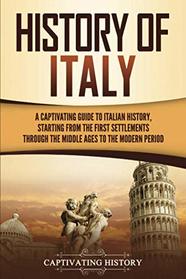The region now known as Italy has had a very long history (starting during the Paleolithic Era -- from about 2.6 million to about 10,000 years ago). It is where the Mediterranean world connects Europe with the Far East through trade and migration. This overview states that the Adriatic Sea level was much lower then; thus Italian land that today is underwater was at one-time a larger area of fertile plains with lakes.
Many groups of peoples migrated across Italy over the generations and by the time of Emperor Octavian Augustus, Italy was considered to be the motherland, provinces were ruled by governors, and some Italian cities were considered to be Roman colonies. Italy was divided into 11 different regions, but Italy was not a unified country yet. One interesting concept of the times was that a soldier claimed two homelands -- Italy and the city where he was born.
Romans of Octavian's time only lived to about 35-years because of the high death rate due to nearly-constant wars and the high childhood mortality rates. Children rarely lived to reach 15-years.
The concept of empire changed in 330 CE, with Constantine the Great when he moved his capital to Constantinople and declared Christianity to be the official religion. Constantine's movement of the capital to the East caused the eventual decline of the Western Roman Empire. He gathered taxes from the Western Empire and used them for building and road construction in the East. Also, the lack of a standing army in Rome led to its sacking and ultimate fall.
In spite of the efforts of many groups, Italy was still not unified by the Middle Ages or even the early Renaissance. Different regions of Italy vied for ascendancy during the Renaissance. Rome fell into ruins during this period. The popes became corrupt and it led to various religious wars. However, the Enlightenment of the French philosophers eventually arrived in Italy and the people insisted that their foreign rulers rule for the benefit of the subjects.
Frankly, the last chapter and the conclusion did not offer a final resolution of Italy. One incredible fact was that Italy lost 1/3 of its population by the end of the first World War. A popular phrase describes the last 20 pages (or so). It was a "hot mess" that really hasn't been resolved with a totally unified Italy. Instead, the country is run as competitive regions, divided by their different cultures and languages, and dialects.
Many groups of peoples migrated across Italy over the generations and by the time of Emperor Octavian Augustus, Italy was considered to be the motherland, provinces were ruled by governors, and some Italian cities were considered to be Roman colonies. Italy was divided into 11 different regions, but Italy was not a unified country yet. One interesting concept of the times was that a soldier claimed two homelands -- Italy and the city where he was born.
Romans of Octavian's time only lived to about 35-years because of the high death rate due to nearly-constant wars and the high childhood mortality rates. Children rarely lived to reach 15-years.
The concept of empire changed in 330 CE, with Constantine the Great when he moved his capital to Constantinople and declared Christianity to be the official religion. Constantine's movement of the capital to the East caused the eventual decline of the Western Roman Empire. He gathered taxes from the Western Empire and used them for building and road construction in the East. Also, the lack of a standing army in Rome led to its sacking and ultimate fall.
In spite of the efforts of many groups, Italy was still not unified by the Middle Ages or even the early Renaissance. Different regions of Italy vied for ascendancy during the Renaissance. Rome fell into ruins during this period. The popes became corrupt and it led to various religious wars. However, the Enlightenment of the French philosophers eventually arrived in Italy and the people insisted that their foreign rulers rule for the benefit of the subjects.
Frankly, the last chapter and the conclusion did not offer a final resolution of Italy. One incredible fact was that Italy lost 1/3 of its population by the end of the first World War. A popular phrase describes the last 20 pages (or so). It was a "hot mess" that really hasn't been resolved with a totally unified Italy. Instead, the country is run as competitive regions, divided by their different cultures and languages, and dialects.




